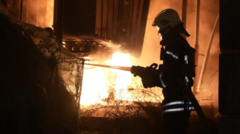How Are Russian Drone Attacks Leading to Widespread Power Outages in Ukraine?

Published: 2025-08-27 16:49:04 | Category: technology
The recent drone attacks by Russia have left over 100,000 Ukrainian homes without power, highlighting the ongoing conflict's devastating impact on civilian infrastructure. Ukrainian President Volodymyr Zelensky reported that these attacks primarily targeted energy facilities in regions such as Poltava, Sumy, and Chernihiv, as part of Russia's strategy to disrupt essential services ahead of the winter season.
Last updated: 15 October 2023 (BST)
Key Takeaways
- Over 100,000 homes in Ukraine are currently without power due to Russian drone strikes.
- Energy infrastructure is being targeted as part of Russia's broader strategy against Ukraine.
- Ukraine has retaliated with strikes on Russian refineries and oil depots.
- Recent military movements indicate ongoing hostilities with no immediate resolution in sight.
- International pressure is being sought to curb Russian aggression and enhance security measures.
Overview of Recent Drone Attacks
On the night of the attacks, President Zelensky reported that Russia executed nearly 100 drone strikes, focusing predominantly on energy facilities. This aggressive action comes as Ukraine braces for the harsh winter months, during which energy supply is critical for heating and other essential services.
In addition to energy facilities, civilian structures such as schools and residential buildings were also affected. This reflects a disturbing trend where civilian infrastructure is increasingly becoming a target in the ongoing conflict.
Context of the Conflict
Since the onset of Russia's full-scale invasion in February 2022, the situation in Ukraine has continued to evolve. The conflict has not only devastated towns and cities but has also severely impacted the nation's energy infrastructure. Last winter, it was reported that Russia had destroyed nearly half of Ukraine's electricity-generating capacity.
The recent attacks are seen as an extension of Moscow's ongoing policy to undermine civilian life in Ukraine. The intent appears to be to create a humanitarian crisis as winter approaches when temperatures plummet and energy needs increase.
Ukrainian Response and Counterattacks
In retaliation for ongoing strikes, Ukrainian forces have also targeted Russian assets, including refineries and oil depots. This reciprocal action underscores the escalating nature of the conflict and the lengths both sides are willing to go to disrupt each other's capabilities.
Ukrainian military officials recently announced that Russian forces had entered the Dnipropetrovsk region for the first time. However, they also reported that the advance was halted, reflecting the ongoing back-and-forth dynamics of the battlefield.
The Humanitarian Impact
With winter looming, the humanitarian implications of these attacks cannot be overstated. The loss of power not only affects heating but also impacts access to clean water, healthcare, and food preservation. The situation is particularly dire for vulnerable populations, including the elderly and those with health conditions.
International humanitarian organisations are closely monitoring the situation and are likely to ramp up efforts to provide support, but the scale of the need is daunting.
International Reactions and Future Implications
President Zelensky has called for increased international pressure on Russia to halt its attacks and ensure the safety of Ukrainian civilians. This plea comes amid discussions with global partners regarding additional measures to protect Ukraine's energy infrastructure.
The international community's response will be crucial in determining the next steps in this conflict. As winter approaches, the urgency of these discussions intensifies, with many nations considering further sanctions against Russia and increased military support for Ukraine.
What Comes Next?
The situation remains fluid, with military engagements continuing on various fronts. As both sides prepare for winter, the potential for further escalations exists. The ongoing attacks on civilian infrastructure likely signal that Russia is willing to intensify its campaign in response to Ukrainian counterattacks.
Looking ahead, the focus will need to be on humanitarian aid and restoring power to affected regions while simultaneously strategising military responses. The involvement of international allies will be pivotal in shaping the outcome of this protracted conflict.
FAQs
What regions in Ukraine were affected by the recent drone attacks?
The recent drone attacks primarily affected the Poltava, Sumy, and Chernihiv regions, leaving over 100,000 homes without power.
What has been the impact of these attacks on civilians?
The attacks have severely impacted civilian life, disrupting power supplies critical for heating and essential services as winter approaches.
How has Ukraine responded to the attacks?
Ukraine has retaliated by targeting Russian refineries and oil depots, demonstrating a reciprocal approach to the ongoing conflict.
What are the international implications of these attacks?
The attacks have prompted calls for increased international pressure on Russia and discussions about additional military support for Ukraine.
What can be expected in the upcoming months regarding the conflict?
As winter approaches, further escalations in military engagements are likely, with both sides preparing for sustained operations while addressing humanitarian needs.
As the situation unfolds, the international community's role will be vital in shaping the future of Ukraine. With the stakes high and winter on the horizon, the need for strategic alliances and humanitarian efforts has never been more pressing. #UkraineConflict #DroneAttacks #HumanitarianCrisis



